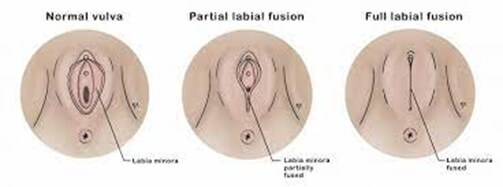
Labial adhesions in babies and children
Labial adhesions are a very common condition in girls, that concerns lots of parents.
In the following post we will learn everything we need to know about this common condition. This post was written by Dr Nataly Koren, a gynecologist who specializes in gynecology for young children and adolescents and you can find out more information about her in the following link.
What exactly are labial adhesions?
When the inner labias (labia minora) adhere together and partially or fully block the opening of the vagina and urethra. Sometimes only a small opening remains, allowing the passage of urine.
What can the symptoms of labial adhesions be?
Most of the time, there are no symptoms at all.
Sometimes it can lead to itchiness, unpleasantness or discomfort in the genitalia, difficulty urinating, inflammatory vaginal discharge (yellowish-green with or without foul odour) or recurrent urinary tract infections. Read more about vaginal discharge here.
What is the prevalence of labial adhesions and when do they occur?
This condition can be found in up to 3% of the population.
It usually begins in the first or second year of life and can last until adolescence (around the time of development of breast buds).
What is the cause of labial adhesions?
The main cause of this condition is low levels of estrogen in the baby/child’s body and this is why the labias adhere temporarily.
Keep in mind that it is completely normal for girls to have these low levels of estrogen at this time of their life.
Additional causes include a combination of lack of estrogen and infection due to inappropriate hygiene and infections or diseases of the skin such as lichen sclerosus.
Who should be responsible for examining the area when labial adhesions are suspected?
As a gynecologist who specialises in children and adolescents, I would like to send a message about the examination of genitalia in young girls.
It is important not to perform excessive examinations of this area. In my opinion, it is important to teach girls that this is a private area and only your parents and physicians (in the presence of parents) are allowed to examine, observe and touch, and only following the patient’s permission.
Lots of girls come to me for an examination after they have been checked by several doctors and after recurrent attempts to open up the adhesions, and so they tend to be very sensitive and refuse to get examined.
It is important to do the least necessary number of examinations and to permit autonomy and privacy at all ages, and at all times.
Do labial adhesions need to be checked by a physician?
Yes. Seeing a pediatrican or a gynecologist who specialises in child and adolescents is advised in order to confirm that the condition is not caused by an infection or skin disease and lack of estrogen.
How can labial adhesions be treated?
Firstly, it is important to decide whether or not treatment is necessary.
If there are no symptoms and urine is able to come out normally, there is no need for treatment, even if the labias are fully fused. Keep in mind that this tends to be a temporary and resolvable condition.
If there are signs and symptoms including vaginal discharge (read more about this here), pain in the genitalia, recurrent urinary tract infections – the condition must be treated.
Should we try and forcefully separate the labias?
The labias should never be forced apart. In addition to the pain this will cause the child, forcefully separating the labias could lead to a wound and scarring of the labias and this may lead to the need for a surgical procedure later in life.
So how can labial adhesions be treated?
Application of topical estrogen cream twice a day for several weeks helps with the spontaneous separation of the labias. Find out more information about this cream here.
This estrogen therapy is successful in about 80% of cases. But it is important to be aware of its side effects, which include temporary development of breast buds.
In addition, it is noteworthy that following treatment there is a high chance of recurrence.
When is surgical treatment required?
Cases requiring surgical treatment are very rare.
A surgical approach under sedation or general anesthesia is taken when the use of topical therapy fails and symptoms of severe urinary tract infections and kidney complications recur.
In summary, this is a very sensitive and common condition. Here too, it is important to examine the details of the individual case so seek medical attention to receive the best suggestions for the management of your particular case.
For comments and questions, please register
